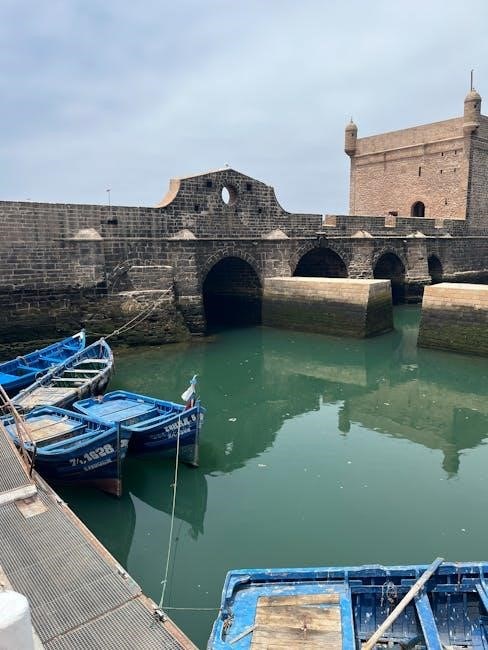
The Rime of the Ancient Mariner, a timeless tale by Samuel Taylor Coleridge, explores moral lessons, supernatural elements, and humanity’s relationship with nature. Available in PDF, it remains a vital literary piece, offering deep insights into guilt, redemption, and the power of the sea, continuing to captivate readers with its haunting narrative and universal themes.
Overview of the Poem
The Rime of the Ancient Mariner by Samuel Taylor Coleridge is a captivating narrative poem that recounts the tale of an aged sailor who recounts his harrowing voyage. The poem begins with the mariner stopping a wedding guest to share his story, which unfolds into a journey marked by supernatural events, moral dilemmas, and profound lessons. Central to the plot is the mariner’s impulsive killing of an albatross, a symbol of good fortune, which unleashes a curse upon the ship. The narrative explores themes of guilt, isolation, and the consequences of one’s actions, all set against the haunting backdrop of the sea and its mysteries. The poem’s rich imagery and symbolic depth have made it a cornerstone of English literature, offering timeless reflections on humanity’s relationship with nature and the divine.
Significance of the PDF Format
The PDF format of The Rime of the Ancient Mariner offers a convenient and accessible way to engage with Coleridge’s masterpiece. It preserves the original text’s formatting and structure, ensuring that readers experience the poem as it was intended. The PDF version is widely available for download from platforms like Litres and Project Gutenberg, making it easily accessible to a global audience. Additionally, its compatibility with various devices allows readers to enjoy the poem on smartphones, tablets, and computers. This digital accessibility has played a crucial role in keeping the poem relevant in the modern era, enabling new generations to explore its themes and symbolism without the need for physical copies. The PDF format thus serves as a bridge between the classic literary work and contemporary readers, ensuring its enduring legacy.
Key Themes and Motifs
The Rime of the Ancient Mariner explores profound themes such as guilt, redemption, and humanity’s relationship with nature. The poem delves into the consequences of the mariner’s actions, emphasizing the moral lesson of respecting all forms of life. The albatross serves as a central motif, symbolizing both good fortune and the burden of guilt. Isolation and loneliness are also prominent, as the mariner endures the curse of his crew’s death and the weight of his tale. Supernatural elements weave through the narrative, reinforcing the idea of a higher power or cosmic justice. These themes, intertwined with vivid imagery, create a timeless story that continues to resonate with readers, inviting reflection on morality, nature, and human existence.

The Plot of The Rime of the Ancient Mariner
The Rime of the Ancient Mariner recounts the mariner’s harrowing voyage, where killing an albatross unleashes a curse, leading to his crew’s death and a journey of guilt and redemption.
The Mariner’s Journey and the Albatross
The ancient mariner embarks on a perilous voyage, recounting his tale to a wedding guest. The ship sails smoothly until it reaches the South Pole, where an albatross appears, bringing calm and hope to the crew. The mariner, in a moment of recklessness, shoots the bird with his crossbow, an act that provokes horror among his comrades. Initially, they blame him for the misfortune, but as the weather worsens, they shift the blame, hanging the dead albatross around his neck as a symbol of guilt. This marked the beginning of the curse, leading to supernatural events and the crew’s tragic fate, isolating the mariner in a world of despair.
The Curse and Its Consequences
The mariner’s impulsive killing of the albatross unleashes a devastating curse, leading to the ship’s crew suffering dire consequences. Initially, the crew condemns the mariner, but as the weather deteriorates, they shift blame, hanging the dead bird around his neck as a symbol of guilt. The curse manifests as unnatural phenomena: the sea becomes eerily calm, and the crew perishes one by one, leaving the mariner isolated and consumed by remorse. The supernatural elements intensify, with spirits and shadows reinforcing the mariner’s torment; The curse ultimately teaches him a profound lesson about respect for all life and the interconnectedness of humanity and nature, transforming his understanding of the world and his place within it.

The Supernatural Elements in the Narrative
The narrative is rich with supernatural elements that shape the poem’s eerie and haunting atmosphere. The albatross, a symbol of good fortune, is killed by the mariner, triggering a series of unnatural events. The ship is surrounded by spectral creatures, and the crew encounters a ghostly figure in a skeletal boat. The mariner’s isolation is deepened by these otherworldly encounters, which serve as a punishment for his actions. The curse that follows the killing of the albatross is a central supernatural theme, leading to the crew’s demise and the mariner’s enduring guilt. These elements not only drive the plot but also explore deeper moral and existential questions, adding layers of complexity to the story.
The Moral Lesson and Redemption
The poem underscores a profound moral lesson, emphasizing the consequences of actions and the path to redemption. The ancient mariner’s killing of the albatross, a symbol of innocence, leads to devastating repercussions, including the death of his crew and his own isolation. Through his suffering, the mariner comes to understand the value of all living beings and the importance of humility. His redemption begins when he appreciates the beauty of the sea creatures, showing that true forgiveness and peace can only be achieved through self-awareness and compassion. This moral framework remains a central theme, resonating with readers and highlighting the universal truths of guilt, atonement, and the human condition.

Themes and Symbolism
Guilt, redemption, isolation, and nature’s power are central themes, with the albatross symbolizing guilt and the mariner’s journey representing humanity’s struggle with sin and forgiveness, conveying deeper moral truths.
The poem delves deeply into the themes of guilt and redemption, as the Ancient Mariner’s journey is a metaphor for humanity’s struggle with sin and forgiveness. His killing of the albatross, a symbol of good fortune, burdens him with overwhelming guilt, leading to the crew’s demise and his isolation. Through his suffering and ultimate realization of the beauty in all creation, the Mariner seeks redemption. This transformation underscores the idea that true forgiveness comes from self-awareness and a deep respect for nature. The poem’s exploration of these themes continues to resonate, offering timeless lessons on personal responsibility and moral growth. The Rime of the Ancient Mariner vividly portrays the awe-inspiring and often terrifying power of nature, particularly the sea. Coleridge uses the mariner’s journey to highlight humanity’s vulnerability against nature’s might. The poem describes the sea as both majestic and deadly, with its unpredictable storms, icy landscapes, and supernatural elements. The albatross, a symbol of good fortune, becomes a harbinger of doom when slain, illustrating the consequences of disrespecting nature’s balance. The mariner’s tale serves as a reminder of nature’s dominance and the need for humility. The sea’s power is both a source of wonder and a force of destruction, underscoring the poem’s central theme of humanity’s place within the natural world. The Rime of the Ancient Mariner deeply explores the themes of isolation and loneliness through the mariner’s harrowing journey. After killing the albatross, the mariner is cursed, leading to the deaths of his crewmates and his subsequent solitude. The poem vividly depicts the mariner’s emotional and physical isolation, as he is left to confront the supernatural consequences of his actions. The weight of his guilt isolates him further, forcing him to wander the earth, recounting his tale to strangers. This loneliness serves as both a punishment and a means of seeking redemption, highlighting the psychological toll of his actions. The mariner’s story becomes a haunting reflection of the human condition, emphasizing the profound impact of isolation on the soul. The Rime of the Ancient Mariner is rich in religious and spiritual symbolism, reflecting themes of sin, redemption, and divine judgment. The albatross, often seen as a symbol of divine grace, is central to the narrative, with its death representing a sacrilegious act. The mariner’s subsequent curse and isolation symbolize the consequences of sin, while his ultimate redemption through prayer and compassion underscores the possibility of forgiveness. The poem also incorporates elements of Christian imagery, such as the cross, to emphasize spiritual struggles and the quest for salvation. These symbols create a profound exploration of humanity’s relationship with the divine, highlighting the moral and spiritual dimensions of the mariner’s journey. The poem serves as a timeless allegory for the human condition, inviting readers to reflect on their own spiritual paths. The Ancient Mariner, a guilt-ridden sailor, narrates his tragic tale, while the albatross symbolizes divine judgment. The ship’s crew and the Wedding Guest represent humanity’s fate and moral inquiry. The Ancient Mariner is portrayed as a tragic hero, burdened by guilt and fate. His unintended killing of the albatross sparks a chain of supernatural events, leading to the crew’s demise and his isolation. The mariner’s journey transforms him from an ordinary sailor into a symbol of humanity’s frailty and the consequences of reckless actions. His haunting tale, recounted to the Wedding Guest, serves as a confession and a plea for redemption. Through his story, Coleridge explores themes of moral responsibility, the power of nature, and the possibility of forgiveness, making the Ancient Mariner one of literature’s most enduring tragic figures. The albatross in The Rime of the Ancient Mariner symbolizes good fortune and divine guidance. Initially, the crew views the bird as a blessing, believing it brings favorable winds. Its presence calms the sailors, representing hope and prosperity. However, when the mariner kills the albatross, the crew’s perception shifts, and the bird becomes a symbol of ill omen. The albatross’s death disrupts the natural harmony, leading to the crew’s downfall. This transformation highlights the delicate balance between nature and humanity, emphasizing the consequences of thoughtless actions. The albatross remains a powerful symbol, teaching a moral lesson about respecting the natural world and its creatures. The ship’s crew in The Rime of the Ancient Mariner plays a pivotal role in the narrative, initially supporting the mariner but later turning against him. They view the albatross as a good omen and blame the mariner for killing it, leading to their collective downfall. As the curse intensifies, the crew members die one by one, leaving the mariner alone and tormented. Their fate serves as a moral lesson, highlighting the consequences of abandoning compassion and failing to understand the natural world. The crew’s story underscores themes of guilt, isolation, and the supernatural, reinforcing the poem’s deeper message about humanity’s relationship with nature and divine forces. Their demise remains a haunting reminder of the mariner’s tale. The Wedding Guest is a pivotal character in The Rime of the Ancient Mariner, serving as the audience within the narrative. The ancient mariner compels him to listen, interrupting his journey to the wedding celebration. The Guest’s curiosity and bewilderment highlight the moral lesson of the tale, as he becomes a silent witness to the mariner’s haunting story. His presence allows the mariner to recount his journey, seeking redemption through confession. The Guest’s role underscores the universal relevance of the mariner’s tale, transforming him from a passive listener to a reflective individual. His experience serves as a bridge between the mariner’s past and the reader’s understanding of guilt and forgiveness. Coleridge’s masterful use of imagery, symbolism, and supernatural elements creates a haunting atmosphere in The Rime of the Ancient Mariner. His vivid descriptions immerse readers in the mariner’s isolating world, while the albatross and other symbols convey profound moral and existential themes, enhancing the poem’s emotional and philosophical depth. Coleridge’s vivid imagery and descriptive language in The Rime of the Ancient Mariner create a haunting and immersive atmosphere, drawing readers into the mariner’s isolated world. The poem’s rich descriptions of the sea, ice, and supernatural elements, such as the albatross and the ghostly ship, evoke powerful visual and emotional responses. The mariner’s journey is painted with stark contrasts, from the serene beauty of the natural world to the eerie dread of the cursed voyage. These images not only enhance the narrative but also underscore the poem’s themes of guilt, redemption, and humanity’s relationship with nature. The detailed descriptions of the mariner’s surroundings and psychological state deepen the reader’s connection to his harrowing tale. Samuel Taylor Coleridge masterfully employs symbolism in The Rime of the Ancient Mariner to convey profound themes and moral lessons. The albatross, a central symbol, represents guilt and isolation, burdening the mariner with its dead weight. The crossbow signifies the destructive act of killing the bird, while the sea embodies the vast, uncontrollable power of nature. The south pole and mist symbolize the unknown and the supernatural, adding depth to the mariner’s eerie journey. The ghostly ship and its spectral figures further enhance the poem’s mystical atmosphere. These symbols, woven throughout the narrative, create a layered exploration of human morality, divine retribution, and the haunting consequences of one’s actions, making the poem a rich tapestry of symbolic meaning and enduring relevance. The supernatural is a cornerstone of The Rime of the Ancient Mariner, shaping its eerie and enigmatic atmosphere. The albatross, a natural creature, takes on a spectral quality after its death, symbolizing guilt and divine retribution. The ghostly ship, crewed by lifeless sailors, haunts the mariner, emphasizing the consequences of his actions. The mist and ice near the South Pole create an otherworldly setting, while the mysterious voice that curses the mariner adds a layer of divine judgment. These elements not only drive the plot but also explore themes of fate, sin, and redemption, making the poem a masterful blend of the natural and supernatural that captivates readers and invites deep reflection. The Rime of the Ancient Mariner, written in the late 18th century, reflects Romanticism’s fascination with nature, guilt, and the supernatural. Its maritime themes resonate with the era’s exploration spirit, blending historical and mystical elements to evoke enduring emotional and philosophical reflection. The Rime of the Ancient Mariner was first published in 1798 within the collection Lyrical Ballads, co-authored with William Wordsworth. Initially, the poem received mixed reviews, with some critics finding it confusing or nonsensical. Over time, however, it gained recognition for its profound themes and imaginative storytelling. By the mid-19th century, it had become a celebrated work, praised for its exploration of guilt, nature, and the supernatural. Today, it is widely regarded as a masterpiece of Romantic literature. The poem’s enduring appeal has led to its availability in various formats, including PDF, making it accessible to modern readers worldwide for study and appreciation. The 18th century was a time of significant cultural and literary transformation, marked by the rise of Romanticism and exploration of the supernatural. The Rime of the Ancient Mariner, written by Samuel Taylor Coleridge in 1798, reflects these trends. The era saw heightened interest in nature, folklore, and the human condition, which deeply influenced Coleridge’s work. The poem’s themes of isolation, guilt, and redemption resonated with audiences amid the societal shifts of the time. The historical context also included maritime adventures and the mystique of the sea, further enriching the narrative. This period’s intellectual climate fostered creativity, making it a fertile ground for Coleridge’s imaginative storytelling. The Rime of the Ancient Mariner is rich in cultural references, drawing from maritime folklore, Christian symbolism, and the mystique of the natural world. The albatross, a central symbol, represents both good fortune and impending doom, reflecting sailors’ superstitions. Biblical themes of sin and redemption are woven throughout the narrative, while the poem’s haunting imagery evokes a sense of the sublime and the divine. Additionally, the poem touches on the cultural fascination with exploration and the unknown, prevalent during the Romantic era. These references enhance the universal appeal of the poem, making it a timeless exploration of human guilt, nature, and spiritual awakening, accessible to readers across different cultural backgrounds and generations. The Rime of the Ancient Mariner is widely available in PDF format on platforms like Litres and Project Gutenberg, enabling easy download or online reading for global accessibility and study. Downloading The Rime of the Ancient Mariner in PDF format is straightforward, with versions available on platforms like Litres, Project Gutenberg, and Docinity. These platforms offer the poem in high-quality digital formats, ensuring readability on various devices. The PDF version preserves the original poetic structure and imagery, making it ideal for academic or personal study. Many websites provide free downloads, while others may require purchase. Users can easily search for “The Rime of the Ancient Mariner PDF” to find reliable sources. This format allows readers to access the poem offline, highlighting its convenience for deeper analysis and appreciation of Coleridge’s work; Reading The Rime of the Ancient Mariner online offers a convenient and accessible way to explore Coleridge’s masterpiece. Websites like Poetry Foundation and Litres provide the poem in digital formats, allowing readers to access it without downloading. The online version is ideal for quick reference or in-class study. Many platforms feature annotations and historical context, enhancing comprehension. Additionally, the Ancient Mariner Big Read project offers serialized readings, making the poem engaging for modern audiences. This online availability ensures that Coleridge’s work remains widely accessible, preserving its relevance and impact in the digital age while maintaining its original literary charm and depth. Study guides and analyses of The Rime of the Ancient Mariner are widely available online, offering in-depth insights into the poem’s themes, symbols, and literary devices. Resources like the Keats-Shelley Journal and Poetry Foundation provide detailed analyses, while educational platforms offer downloadable PDF guides tailored for students. These materials explore Coleridge’s use of guilt, redemption, and nature, as well as the poem’s historical context. Many guides include summaries, character analyses, and interpretations of key motifs, such as the albatross and the mariner’s journey. These resources are invaluable for scholars and readers seeking to deepen their understanding of the poem’s complexity and enduring relevance in literature. They are easily accessible and often free to download or view online, making them a great aid for study and analysis.Guilt and Redemption in the Poem


The Power of Nature and the Sea
Isolation and Loneliness
Religious and Spiritual Symbolism

Characters and Characterization
The Ancient Mariner: A Tragic Hero
The Albatross as a Symbol of Good Omen

The Ship’s Crew and Their Fate

The Wedding Guest and His Role in the Story
Literary Devices and Style
Use of Imagery and Description
Coleridge’s Use of Symbolism
The Role of Supernatural Elements
Cultural and Historical Context
Publication History and Reception
Historical Background of the 18th Century
Cultural References in the Poem

Availability and Access
Downloading the PDF Version
Reading the Poem Online
Study Guides and Analysis